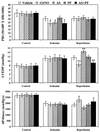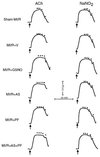Opposite effects of nitric oxide and nitroxyl on postischemic myocardial injury
- PMID: 10588754
- PMCID: PMC24485
- DOI: 10.1073/pnas.96.25.14617
Opposite effects of nitric oxide and nitroxyl on postischemic myocardial injury
Abstract
Recent experimental evidence suggests that reactive nitrogen oxide species can contribute significantly to postischemic myocardial injury. The aim of the present study was to evaluate the role of two reactive nitrogen oxide species, nitroxyl (NO(-)) and nitric oxide (NO(.)), in myocardial ischemia and reperfusion injury. Rabbits were subjected to 45 min of regional myocardial ischemia followed by 180 min of reperfusion. Vehicle (0.9% NaCl), 1 micromol/kg S-nitrosoglutathione (GSNO) (an NO(.) donor), or 3 micromol/kg Angeli's salt (AS) (a source of NO(-)) were given i.v. 5 min before reperfusion. Treatment with GSNO markedly attenuated reperfusion injury, as evidenced by improved cardiac function, decreased plasma creatine kinase activity, reduced necrotic size, and decreased myocardial myeloperoxidase activity. In contrast, the administration of AS at a hemodynamically equieffective dose not only failed to attenuate but, rather, aggravated reperfusion injury, indicated by an increased left ventricular end diastolic pressure, myocardial creatine kinase release and necrotic size. Decomposed AS was without effect. Co-administration of AS with ferricyanide, a one-electron oxidant that converts NO(-) to NO(.), completely blocked the injurious effects of AS and exerted significant cardioprotective effects similar to those of GSNO. These results demonstrate that, although NO(.) is protective, NO(-) increases the tissue damage that occurs during ischemia/reperfusion and suggest that formation of nitroxyl may contribute to postischemic myocardial injury.
Figures






Similar articles
-
S-nitrosoglutathione improves functional recovery in the isolated rat heart after cardioplegic ischemic arrest-evidence for a cardioprotective effect of nitric oxide.J Pharmacol Exp Ther. 1995 Jul;274(1):200-6. J Pharmacol Exp Ther. 1995. PMID: 7616400
-
The opposite effects of nitric oxide donor, S-nitrosoglutathione, on myocardial ischaemia/reperfusion injury in diabetic and non-diabetic mice.Clin Exp Pharmacol Physiol. 2017 Aug;44(8):854-861. doi: 10.1111/1440-1681.12781. Clin Exp Pharmacol Physiol. 2017. PMID: 28500760
-
Nitroxyl affords thiol-sensitive myocardial protective effects akin to early preconditioning.Free Radic Biol Med. 2003 Jan 1;34(1):33-43. doi: 10.1016/s0891-5849(02)01179-6. Free Radic Biol Med. 2003. PMID: 12498977
-
Neuroprotective properties of nitric oxide.Ann N Y Acad Sci. 1999;890:301-11. doi: 10.1111/j.1749-6632.1999.tb08007.x. Ann N Y Acad Sci. 1999. PMID: 10668435 Review.
-
Attenuation of myocardial ischemia-reperfusion injury with nitric oxide replacement therapy.Ann Thorac Surg. 1995 Sep;60(3):847-51. doi: 10.1016/0003-4975(95)00423-I. Ann Thorac Surg. 1995. PMID: 7677545 Review.
Cited by
-
Angeli's salt counteracts the vasoactive effects of elevated plasma hemoglobin.Free Radic Biol Med. 2012 Dec 15;53(12):2229-39. doi: 10.1016/j.freeradbiomed.2012.10.548. Epub 2012 Oct 23. Free Radic Biol Med. 2012. PMID: 23099417 Free PMC article.
-
Positive inotropic and lusitropic effects of HNO/NO- in failing hearts: independence from beta-adrenergic signaling.Proc Natl Acad Sci U S A. 2003 Apr 29;100(9):5537-42. doi: 10.1073/pnas.0937302100. Epub 2003 Apr 18. Proc Natl Acad Sci U S A. 2003. PMID: 12704230 Free PMC article.
-
The return of the Scarlet Pimpernel: cobalamin in inflammation II - cobalamins can both selectively promote all three nitric oxide synthases (NOS), particularly iNOS and eNOS, and, as needed, selectively inhibit iNOS and nNOS.J Nutr Environ Med. 2007 Sep;16(3-4):181-211. doi: 10.1080/10520290701791839. J Nutr Environ Med. 2007. PMID: 18836533 Free PMC article.
-
The Chemical Biology of NO that Regulates Oncogenic Signaling and Metabolism: NOS2 and Its Role in Inflammatory Disease.Crit Rev Oncog. 2023;28(1):27-45. doi: 10.1615/CritRevOncog.2023047302. Crit Rev Oncog. 2023. PMID: 37824385 Free PMC article. Review.
-
Nitroxyl accelerates the oxidation of oxyhemoglobin by nitrite.Nitric Oxide. 2013 May 31;31:38-47. doi: 10.1016/j.niox.2013.03.006. Epub 2013 Mar 30. Nitric Oxide. 2013. PMID: 23545404 Free PMC article.
References
-
- Moncada S, Higgs E A. FASEB J. 1995;9:1319–1330. - PubMed
-
- Schulz R, Wambolt R. Cardiovasc Res. 1995;30:432–439. - PubMed
-
- Wang P H, Zweier J L. J Biol Chem. 1996;271:29223–29230. - PubMed
-
- Woolfson R G, Patel V C, Neild G H, Yellon D M. Circulation. 1995;91:1545–1551. - PubMed
-
- Ferrari R. Am J Cardiol. 1995;76:17B–24B. - PubMed
MeSH terms
Substances
LinkOut - more resources
Full Text Sources
Other Literature Sources
Research Materials

